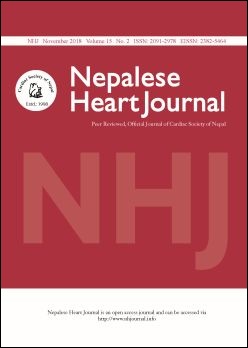Behavioural risk factors associated with ischemic heart disease among population attending selected cardiac hospitals of Kathmandu, Nepal
DOI:
https://doi.org/10.3126/njh.v15i2.21473Keywords:
Ischemic Heart Diseases, Matched Case-control studies, Risk factors.Abstract
Background and Aims: Ischemic Heart Disease (IHD) is the number one cause of morbidity and mortality among the in-patient of different cardiac hospital of developing countries like Nepal. The prevalence of IHD is high with significant associated risk factors that include tobacco use, history of hypertension, family history and age. Though IHD can cause life-threatening conditions like myocardial infarction, yet it is preventable disease. The objective of the study was to study the risk factors associated with ischemic heart diseases among population attending selected cardiac hospitals of Kathmandu.
Methods: Hospital- based pair matched case-control was conducted among the patients with IHD at Manmohan Cardiothoracic Vascular and Transplant Centre (MCTVC) and Shahid Gangalal National Heart Center (SGNHC). Non- random purposive sampling technique was applied and sample size was calculated as 105 (35 cases and 70 controls). Case and control were matched with age (Å} 2 years) and sex from the same hospitals. Ethical approval was taken from Institutional review board, Institute of medicine. Informed consent was obtained prior to information collection, after explaining about the purpose of the study to the entire participants. Only interested participants were included in the study. Confidentiality of the subject was ensured by collecting data in separate private room. Univariate associations between the risk factors and IHD under study was assessed by applying Chi-Square test and Fisher’s exact test and expressed as odds ratios with 95% confidence intervals. To assess the strength of association, the odds ratio was calculated.
Results: 88.6% cases and 90% controls participants were of age 41 years and above and IHD was more common in male (60%) than female (40%). The participants who were not doing work-related moderate-intense activity are twice more likely to have IHD compared to controls (OR=2.276, p=0.049), similarly, hypertensive are two times (OR=2.276, p=0.049), obese are more than two times (OR=2.44, p=0.045), and participants with high waist to hip ratio are almost three times more likely to suffer from IHD (OR=2.88, p=0.013).
Conclusions: The current smoking, physical inactivity, hypertension and waist to hip ratio tend to be the significant risk factors of IHD. Minimizing exposure to the identified risk factors can prevent burden of complex and expensive IHD treatment.
Downloads
Downloads
Published
How to Cite
Issue
Section
License
This license enables reusers to distribute, remix, adapt, and build upon the material in any medium or format, so long as attribution is given to the creator. The license allows for commercial use.




